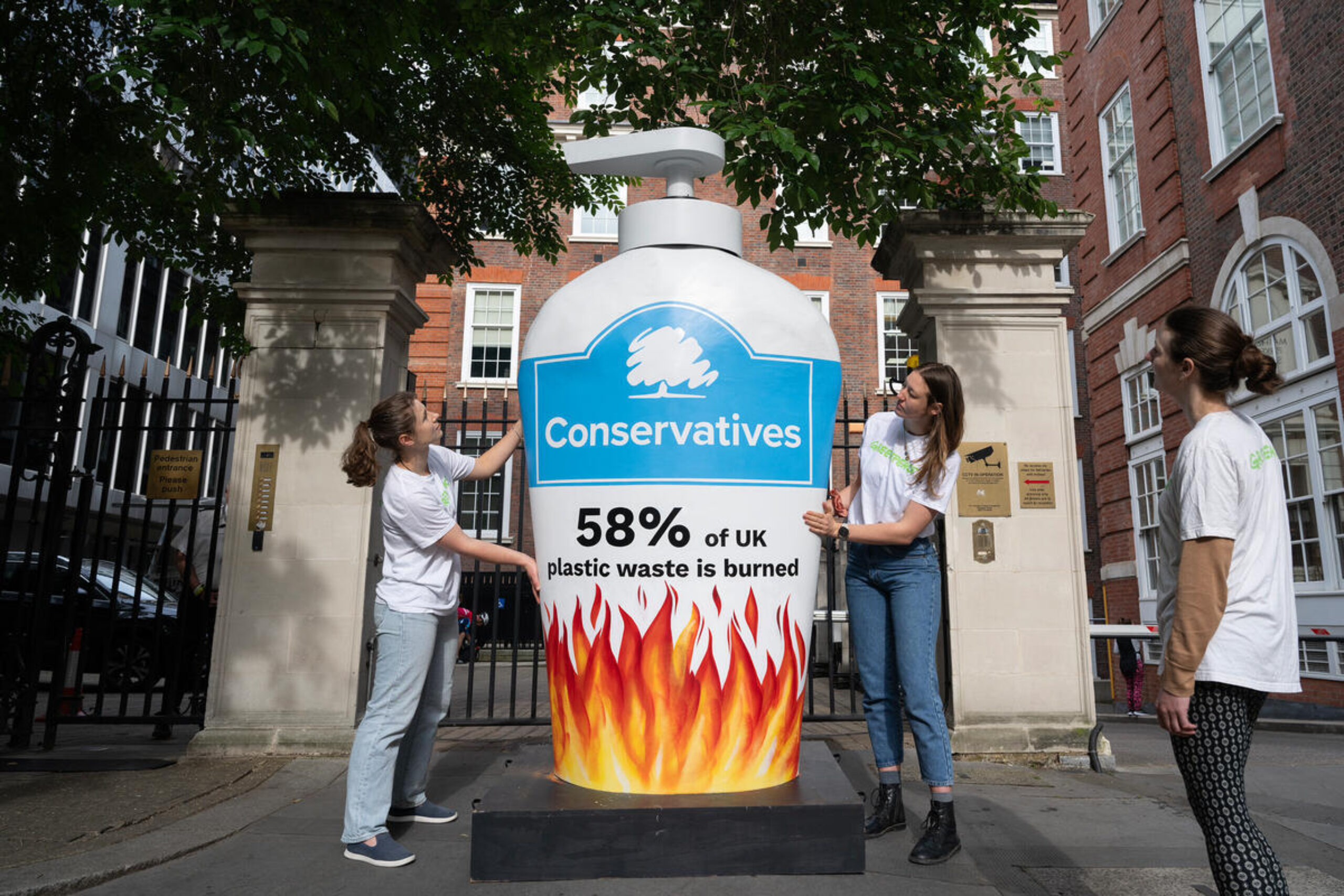
- Press Release
Giant 10 ft bottle confronts Tory election workers with plastic pollution failure.
Workers at Conservative Campaign Headquarters were today greeted by a 10ft tall bottle with flames painted on it highlighting the government’s 14 years of failure on plastic pollution.
The giant bottle, deposited outside the gates of CCHQ in Westminster by Greenpeace UK activists, features Conservative party branding above rising flames representing the overwhelming amount of plastic waste burnt in the UK each year.
The Conservatives once held up their plans on plastic pollution as the jewel in the crown of their environmental agenda. But now plastic waste barely features in their manifesto plans following a litany of false starts, delayed initiatives and broken promises by successive governments over 14 years. The list of government failures on plastic waste include:
- The repeated delays to the Deposit Return Scheme for drinks containers, expected to launch in 2028 at the earliest – a full decade after was first announced.
- The failure to ban the export of UK waste to non-OECD countries as promised in the 2019 manifesto
- The failure to design an Extended Producer Responsibility scheme that encourages reuse and reduction of packaging
- The failure to join 33 other countries in calling for agreement within UN Plastics Treaty negotiations to cut plastic production.
- The huge amounts of plastic waste which continues to be burnt in incinerators. The Big Plastic Count this year demonstrated that of the 1.7 billion pieces of plastic thrown away by UK households weekly 58% will be burned versus 17% recycled. [1]
Negotiations for a Global Plastics Treaty are ongoing and will offer the next government an opportunity to demonstrate leadership on the global stage. Greenpeace UK is urging whoever makes up the next government to take rapid action to get to grips with the growing plastics crisis and claim the economic benefits of a circular economy by:
- Rejecting the previous government’s weak approach to the Global Plastics Treaty negotiations and increasing the level of ambition and leadership to secure a strong global target to cut plastic production.
- Implement a comprehensive Deposit Return Scheme, an Extended Producer Responsibility Scheme that makes plastic polluters pay and incentivises a move towards reuse and refill culture, ban waste exports and new incinerators.[2]
Laura Burley, Campaigner at Greenpeace UK said:
“A decade and a half of successive Conservative governments have let the plastics crisis spiral out of control. Action on plastic waste was once the centerpiece of the Conservative environmental agenda and yet today this crisis barely warrants a mention in their manifesto following a litany of failure and broken promises. To the public’s horror, overwhelming amounts of plastic continue to be burnt, dumped or exported overseas.
This can change. The next government will be coming in at a crucial time for the global fight against plastic waste. They have a once-in-a-generation opportunity this autumn to lead on the world stage in November’s Global Plastic Treaty negotiations. The UK must use its influence to help build consensus and bolster ambition around a strong Global Plastics Treaty that secures global cut in plastic production. That’ll only happen if they seize the moment and seize it quickly – or they risk chalking up another government failure early on in the new parliament.”
ENDS
Notes to editors:
IMAGES: https://media.greenpeace.org/
[2] Greenpeace are calling for the next government to back targets to eliminate non-essential single-use packaging by the late 2030s and a 30% reuse target by 2030, including through immediately implementing an all-in Deposit Return Scheme (DRS) for recycling and reuse and Extended Producer Responsibility (EPR) requirements that promote reuse and packaging reduction. Alongside this, to commit to a complete ban on all plastic waste exports by 2027 at the latest, and ending approvals for new incineration facilities.
